What are the 5 Types of Leather: An In-Depth Guide!
- Home
- Editor's Desk
- What are the 5 Types of Leather: An In-Depth Guide!
- 3rd Anniversary Gifts
- ALL PRODUCTS
- Aprons
- BACKPACKS
- Best Sellers
- Bridesmaid Gifts
- BUSINESS PORTFOLIOS
- Chef Collectibles
- Desk Mats
- Father's Day Gifts
- For the Writers
- For Your Business
- for-the- travels
- Gifts $100-$200
- Gifts $50-$100
- Gifts Under $50
- Graduation Gifts
- Groomsmen Gifts
- KNIFE ROLLS
- LEATHER JOURNALS
- Men Collection
- MEN WALLETS
- MESSENGER BAGS
- MISCELLANEOUS
- Mother's Day Gifts
- New arrivals
- PENCIL CASES
- Rustic Town X Women
- SATCHEL
- TOILETRY BAGS
- Totes
- TRAVEL BAGS
- Travel Essentials
- Watch Case
- WOMEN BAGS
- Women Collection
- Women Wallets
- ##bound
- #2024
- #aestheticjournal
- #AffordableLeatherGoods
- #AirlineGuidelines
- #americanbisonvsbuffalo
- #americanbuffalovsbison
- #AmericanWildlife
- #antiquejournal
- #apron
- #ApronComfort
- #ApronCraftsmanship
- #ApronFashion
- #ApronInspiration
- #ApronProtection
- #aprons
- #ApronStyle
- #ArtisanApron
- #ArtisanLeather
- #ArtOfWriting

Leather, a material synonymous with durability, luxury, and versatility, has adorned human societies for millennia. From the rugged boots of a traveler to the sleek wallet in a businessperson’s pocket, leather's presence is ubiquitous. Yet, the journey from hide to high fashion is intricate, influenced by various factors such as the animal of origin, the cut of the hide, and the tanning process. This article delves into the fascinating world of leather, exploring its types, grades, and the nuances of its care.
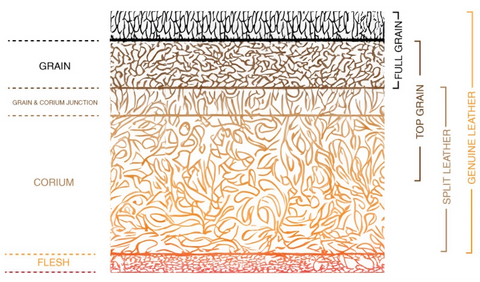
What Defines Leather Quality and Grades?
The quality and grade of leather are pivotal in determining its aesthetic, durability, and price. The classification into various grades reveals the material's inherent beauty and potential applications.
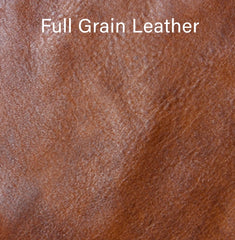
Full-grain leather is considered the highest quality of leather. It's made from the outer layer of the animal hide and includes the natural grain with minimal processing. This type of leather is not sanded or polished to remove imperfections, which means it retains the original texture and markings of the animal's skin.
- How It’s Made: Preserved closest to its natural state, it undergoes minimal processing.
- Characteristics: Durable, ages gracefully, developing a patina over time.
- Care and Maintenance: Requires conditioning and occasional waterproofing.
- Common Uses: High-end furniture, duffle bags, luxury goods, durable footwear.
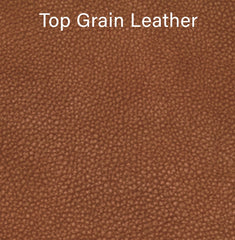
Top-grain leather is the second-highest quality of leather. It's like full-grain leather but has had the very top layer sanded off to remove imperfections. This makes the leather thinner and more pliable than full-grain, with a more uniform appearance.
- How It’s Made: Sanded and finished to create a more uniform appearance.
- Characteristics: Softer, more pliable than full-grain, with good durability.
- Care and Maintenance: Regular cleaning and conditioning to maintain its appearance.
- Common Uses: Quality handbags, jackets, and upscale upholstery.
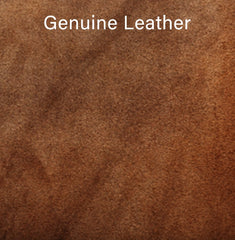
Genuine leather is often misunderstood as top-quality leather, but it refers to the lower quality of leather made from the leftover parts of the hide after the higher-quality tiers have been removed. It's often treated and colored to look like higher-grade leather.
- How It’s Made: Made from leftover materials, it can be layered or a single piece from the hide.
- Characteristics: Varies widely in quality and durability, less durable than higher grades.
- Care and Maintenance: Needs protection and care to extend life.
- Common Uses: Budget-friendly accessories, shoes, and garments.
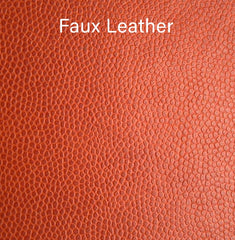
Faux leather, also known as synthetic leather, is a man-made material that mimics the appearance and feel of real leather but is made without using animal hide. It can be made from various materials, including polyurethane (PU) or vinyl.
- How It’s Made: Composed of plastic and other materials, embossed to look like leather.
- Characteristics: Less durable, may crack over time, but animal friendly.
- Care and Maintenance: Easy to clean, typically requires just a damp cloth.
- Common Uses: Vegan fashion items, affordable furniture, and accessories.
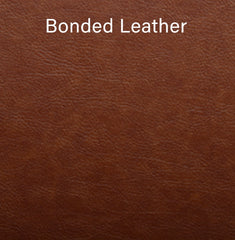
Bonded leather is made from the scraps and fibers left over from manufacturing genuine leather, mixed with polyurethane or latex on top of a fiber sheet. The mixture is then embossed with a leather-like texture. It contains a small percentage of actual leather, often less than 20%.
- How It’s Made: These remnants are ground together, then attached to a backing.
- Characteristics: Less durability, the surface can peel or flake.
- Care and Maintenance: Like faux leather, easy to clean but less resilient.
- Common Uses: Economical furniture and book bindings.
How Do Leather Types Vary by Animal?
The source animal remarkably influences leather’s characteristics. While cowhide reigns supreme in popularity due to its versatility and durability, other animals offer unique traits.
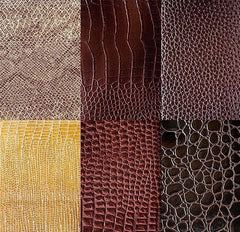
- Sheepskin: Known for its softness and flexibility, sheepskin is often used in luxury clothing and soft accessories.
- Goatskin: Offers an appealing texture and high durability, making it suitable for high-end book covers, bags, handbags, and gloves.
- Exotic Leathers: Sourced from alligators, ostriches, and even snakes, these leathers are prized for their unique textures and patterns, commanding a premium in the luxury market for their distinctive appeal and durability.
Why Exotic Leather, Considered Luxurious?
Exotic leathers, derived from uncommon sources like alligators or ostriches, boast unique textures and high durability. Their rarity and the meticulous process required to craft them into finished goods contribute to their luxurious status and high price point.
What Are the Most Common Misconceptions About Leather Grades?
A widespread misconception is that genuine leather signifies high quality. It denotes one of the lower grades of leather, less durable and prestigious than full-grain or top-grain leather.
How Does Leather Care Differ Among Types?
Care strategies vary significantly across leather types. Full-grain leather requires conditioning to maintain its patina, while faux and bonded leathers need minimal care, primarily regular cleaning. Each leather type benefits from specific maintenance practices to preserve its quality and appearance.
What Are the Different Leather Cuts?
The way a leather hide is cut affects its overall thickness, resilience, and potential uses.

-
Whole Hide Cuts: These are the largest and most complete sections of leather available, perfect for creating sizable items without seams.
-
Side Cuts: This refers to dividing a whole hide into two equal parts, offering a good mix of size and ease of handling, commonly utilized in making furniture and automotive seats.
-
Targeted Cuts: Including specific areas like the belly or shoulder, these cuts vary in thickness and strength, making them ideal for specialized items such as belts, straps, or shoes.
Can Top Grain Leather Be Considered a Good Balance Between Quality and Affordability?
Top grain leather represents a sweet spot for many consumers, offering a harmonious blend of quality, durability, and affordability. It’s suitable for a wide range of premium products without the higher cost associated with full-grain leather.
How Does the Tanning Process Affect Leather Types?
Tanning transforms hides into durable, usable leather. The two primary methods are:
- Vegetable-Tanned Leather: Utilizes natural materials like tree bark, creating a firm and color-rich leather that ages beautifully. It’s environmentally friendlier but more susceptible to water damage.
- Chrome-Tanned Leather: Uses chromium salts, resulting in softer, more flexible leather available in a variety of colors. It’s quicker and less labor-intensive than vegetable tanning, but its environmental impact is more significant.
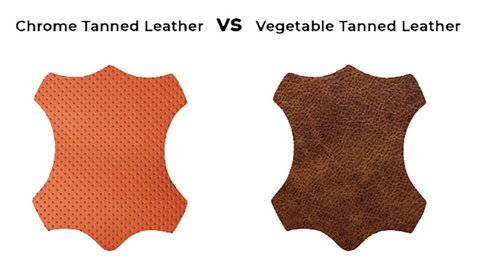
What are the environmental impacts of different leather types?
Leather production, regardless of the type, has various environmental impacts that can be significant, depending on the processes, chemicals, and resources used. Here's a breakdown of different leather types and their potential environmental impacts:
Traditional Leather (from animals)
-
Resource Intensive: Traditional leather comes primarily from cows, and the livestock industry is a significant source of methane, a potent greenhouse gas. It also requires considerable amounts of water and land.
-
Chemical Use: The tanning process often involves harmful chemicals like chromium, which can lead to water pollution and affect the health of workers in tanneries.
-
Biodegradability: Though natural leather is biodegradable, the tanning process can slow this down significantly.
Synthetic Leather (e.g., PVC, PU leather)
-
Lower Natural Resource Use: Synthetic leathers require less land and water than traditional leather, as they are made from petroleum-based materials.
-
Chemical Pollution: The production of synthetic leather involves toxic chemicals, including plasticizers, that can be harmful to the environment and human health.
-
Non-Biodegradable: Materials like PVC are not biodegradable and can persist in the environment for hundreds of years, contributing to plastic pollution.
Plant-based Leathers (e.g., mushroom leather, apple leather)
-
Sustainable Resources: These leathers are made from renewable resources, requiring less land, water, and energy compared to traditional leather.
-
Lower Chemical Use: The manufacturing process for plant-based leathers often uses fewer toxic chemicals, reducing pollution and health risks.
-
Biodegradability: Most plant-based leathers are biodegradable and compostable, making them more environmentally friendly in terms of disposal.
Lab-grown Leather
-
Reduced Resource Use: Lab-grown leather aims to mimic traditional leather without the environmental footprint of raising livestock. It uses cellular agriculture techniques to grow leather in a lab.
-
Potential for Lower Chemical Use: The process could potentially use fewer harmful chemicals, depending on the methods employed.
-
Ethical Considerations: It eliminates the need for animal slaughter and could significantly reduce the environmental impact if scaled sustainably.
Environmental Considerations
When evaluating the environmental impact of leather types, it's essential to consider:
-
The full lifecycle of the product, including production, use, and disposal.
-
Carbon footprint, water usage, and chemical pollution.
-
The sustainability of the raw materials used.
-
Ethical considerations, especially concerning animal welfare.
Conclusion
Leather remains a material of choice for countless applications, celebrated for its versatility, durability, and timeless appeal. Understanding its various types, grades, and care requirements enables consumers and craftsmen alike to make informed decisions, ensuring the longevity and beauty of leather goods.
For those interested in further understanding the regulations and guidelines around leather production and tanning, there are several government resources available that can provide detailed insights.
The U.S. Environmental Protection Agency (EPA) has set Effluent Guidelines for the Leather Tanning and Finishing industry, which outline the regulatory requirements for direct and indirect dischargers to control the pollutants discharged into waters of the United States. These guidelines have been amended several times since their initial promulgation in 1974, reflecting ongoing efforts to mitigate environmental impacts associated with leather tanning and finishing processes. For comprehensive details on these regulations, you can visit the EPA's official page on Leather Tanning and Finishing Effluent Guidelines at www.epa.gov/eg/leather-tanning-and-finishing-effluent-guidelines (US EPA).
Shop Our Leather Collection of:
Travel Bag | Messenger Bag | Women Bags | Journals | Portfolios | Toiletry Bags | Satchels | Pencil Cases | Knife Roll











